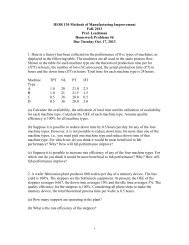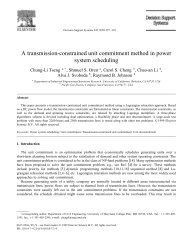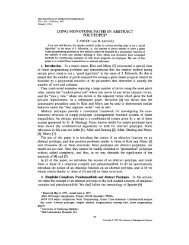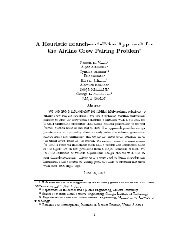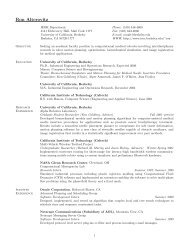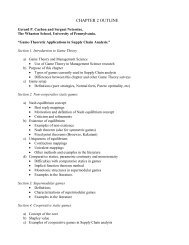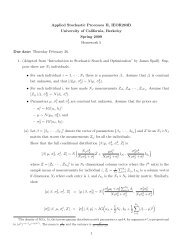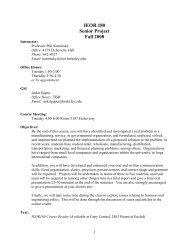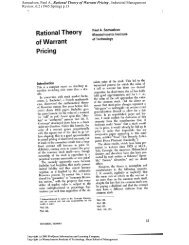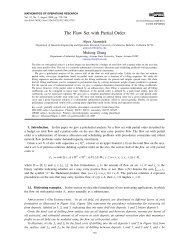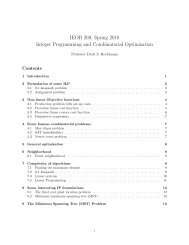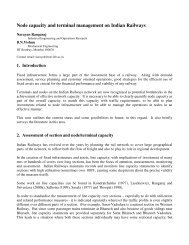Hedging Quantity Risks with Standard Power Options - UC Berkeley ...
Hedging Quantity Risks with Standard Power Options - UC Berkeley ...
Hedging Quantity Risks with Standard Power Options - UC Berkeley ...
Create successful ePaper yourself
Turn your PDF publications into a flip-book with our unique Google optimized e-Paper software.
708 Naval Research Logistics, Vol. 53 (2006)<br />
3.3. An Example<br />
In this section, we illustrate the method that we derived<br />
in the previous sections. We consider the on-peak hours of<br />
a single summer day as time 1. Parameters were approximately<br />
based on the California <strong>Power</strong> Exchange data of<br />
daily day-ahead average on-peak prices and 1% of the total<br />
daily on-peak loads from July to September 1999. Specific<br />
parameter values are imposed as follows:<br />
• Price is distributed lognormally <strong>with</strong> parameters<br />
m1 = 3.64 and s = 0.35 in both the real-world<br />
and risk-neutral world: log p ∼ N(3.64, 0.35 2 ) in<br />
P and Q. The expected value of the price p under<br />
this distribution is $40.5/MW h.<br />
• The fixed rate r = $100/MW h is charged to the<br />
customers who are served by the LSE.<br />
• For CARA utility, the risk aversion is a = 1.5.<br />
• Load is either normally distributed <strong>with</strong> mean m =<br />
300 and u 2 = 30 2 or lognormally distributed <strong>with</strong><br />
parameter m = 5.77 and u = 0.09.<br />
We would like to point out a significant correlation effect<br />
in the profit distributions. Figure 1 shows that the profit distributions<br />
become quite different as the correlation between<br />
load and logarithm of price changes. Considering that the correlation<br />
coefficient of our data is 0.7, we observe that the correlation<br />
coefficient cannot be ignored in the analysis of profit.<br />
The optimal payoff functions for a CARA utility LSE<br />
are drawn in Figure 2 for various correlation coefficients<br />
between log p and q. Generally, low profit from high loads for<br />
Figure 1. Profit distribution for various correlation coefficients.<br />
Generated 50,000 pairs of (p, q) from a bivariate normal distribution<br />
of (log p, q) <strong>with</strong> a various correlation ρ’s, where log p ∼<br />
N(3.64, 0.35 2 ) and q ∼ N(300, 30 2 ) and plotted estimated probability<br />
density functions of the profit using normal kernel (assuming<br />
r = $100/MW h). [Color figure can be viewed in the online issue,<br />
which is available at www.interscience.wiley.com.]<br />
Figure 2. The optimal payoff function for an LSE <strong>with</strong> CARA<br />
utility when price and load follow bivariate lognormal-normal distribution<br />
log p ∼ N(3.64, 0.35 2 ) and q ∼ N(300, 30 2 ) <strong>with</strong> correlation<br />
coefficient ρ. [Color figure can be viewed in the online issue, which<br />
is available at www.interscience.wiley.com.]<br />
very high spot prices and from low load for very low spot price<br />
is compensated <strong>with</strong> the cases where spot prices and loads are<br />
around the expected value. This can be seen from the graph<br />
where as the spot price goes away from r, positive payoff is<br />
received from the optimal portfolio while the payoff is negative<br />
around r. We also note that larger payoff can be received<br />
when the correlation is smaller. This is because the variance<br />
of profit is bigger when the correlation is smaller, as we can<br />
see from Figure 1. Therefore, even when the correlation is<br />
zero, the optimal payoff function is nonlinear.<br />
Figure 3 illustrates the numbers of contracts to be purchased<br />
in order to obtain the payoff x ∗ (p) for an LSE <strong>with</strong> a<br />
CARA utility function. We see that the numbers of options<br />
contracts are very high relative to the mean volume. This<br />
is because we don’t restrict the model <strong>with</strong> constraints such<br />
as credit limits. The zero-cost constraint (2) that we only<br />
included in our model enables borrowing as much money as<br />
needed to finance any number of derivative contracts.<br />
For an LSE <strong>with</strong> mean-variance utility, the optimal payoff<br />
functions are drawn in Figure 4. They show the tendency of<br />
mean-variance utility to protect against high price and low<br />
quantity. For an illustration of the numbers of contracts to be<br />
purchased in order to obtain payoff x ∗ (p), see Figure 5. Note<br />
that in our examples the number of options contracts to be<br />
purchased in the optimal portfolio is positive for any strike<br />
prices. This implies that we borrow money from the bank and<br />
purchase a portfolio of options contracts.<br />
Figure 6 compares distribution changes between profit<br />
<strong>with</strong>out hedging, profit after price hedge 14 and profit after<br />
14 Price hedge here means that we add the optimal payoff function<br />
obtained under the assumption of no quantity risk. This is in fact<br />
equivalent to buying forwards for the average load quantity.<br />
Naval Research Logistics DOI 10.1002/nav



